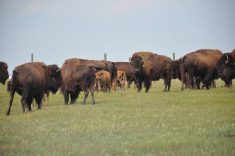CAROLINE, Alta. – Sandwiched between two national parks and sharing land with other users, Clearwater County in west-central Alberta has its own set of challenges when trying to control weeds on native range.
Home to 1,200 farmers, the 8,200 sq. mile county is between Banff and Jasper national parks. There is extensive logging, oil and gas activity as well as recreational pursuits, all capable of introducing foreign weeds and creating an explosion of invasive plants.
So far, the serious invasive plant species troubling other jurisdictions haven’t been a big problem in Clearwater, but agriculture fieldman Kim Nielson told a pasture management seminar in Caroline that invasive species are the second largest threat to biodiversity after the loss of habitat.
Read Also

Good handling equipment a must on cattle operations
It’s important for the safety of producers and everyone else dealing with their stock that handling equipment is functional and safe.
He said they outcompete native grasses and wildflowers, including rare and endangered species. They can clog waterways and cause allergic reactions in people.
Nielson said it is important to identify plants that may have moved in on machinery or hay supplies.
Through his involvement with the Alberta invasive plants council and as a director with the North American Weed Management Association, he watches for toadflax, leafy spurge, scentless chamomile, oxeye daisy, tall buttercup, orange hawkweed and common crupia.
Plants from Montana such as common crupia and orange hawkweed have not been found in Alberta so far and knapweed from British Columbia has not yet moved east.
Leafy spurge has caused considerable problems in some Alberta municipalities. Weed managers have been unable to eliminate it and rangeland may never return to normal.
Scentless chamomile is appearing but municipalities should be able to control it by working with government departments such as forestry.
Tall buttercup is another troublesome weed. Wildlife and livestock reject the tall yellow flowering plant, which can cause internal inflammation and may kill young calves.
Other weeds are allopathic, meaning they emit a poison into the soil that keeps other plants from germinating.
Herbicides can help control the weed problem. Grazon, from Dow AgroSciences, can remove weeds to improve pasture production while Remedy, also from Dow, can clean out woody plants and brush for five to seven years.
Nielson also advises use of certified weed-free hay and suggests equipment, including all-terrain vehicles, be cleaned to prevent seed movement.
Urban anti-pesticide movements could be a challenge, forcing herbicide use to become a balancing act.
“People will realize eventually that there are environmental impacts on plants,” he said.
Nielson advocates a regional weed watch list among municipalities as well as a co-operative management plan between provinces to control invasive plants.















